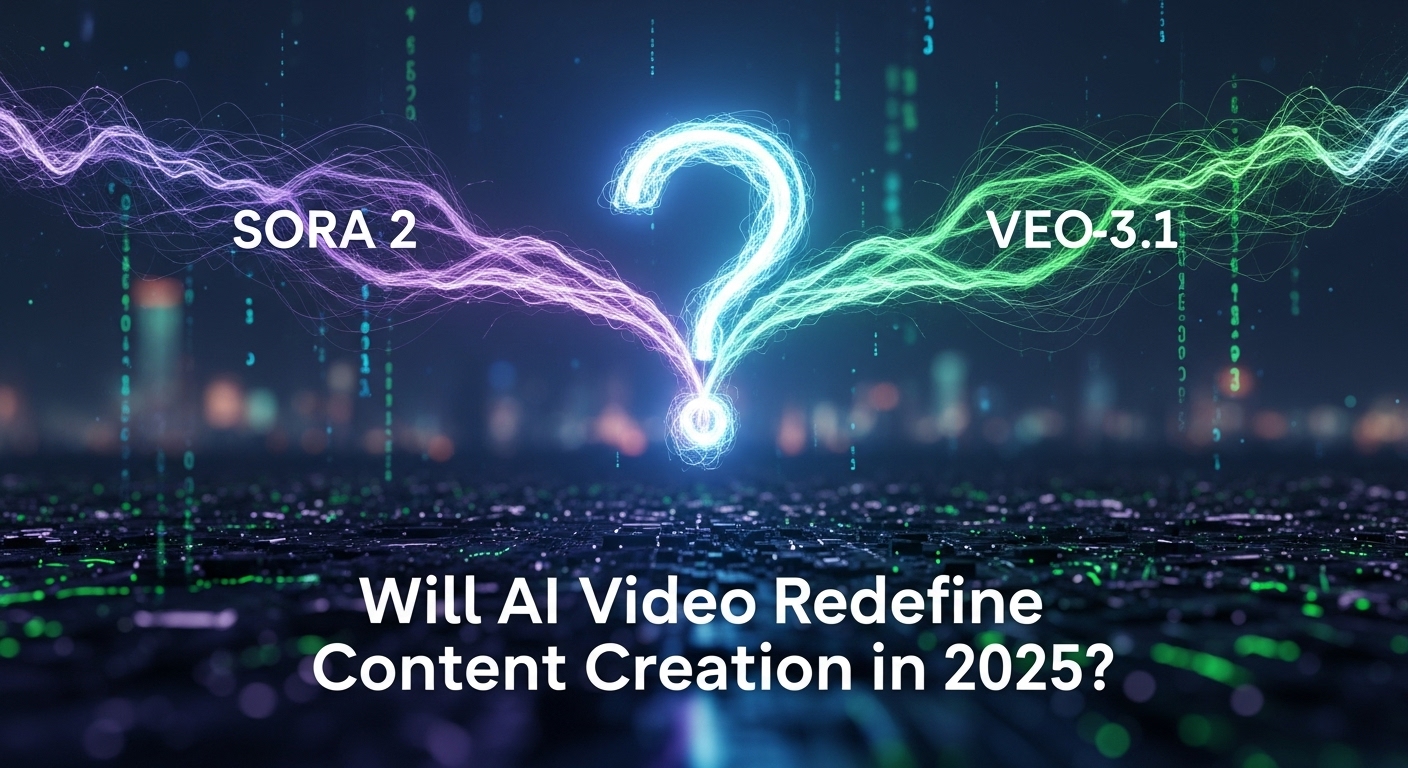【2025年最新】OpenAI「Sora 2」とGoogle「Veo 3.1」が巻き起こす動画革命の最前線!クリエイターよ、この波に乗れ!
2025年、AIによる動画生成は、かつてないほど急速な進化を遂げ、クリエイティブ業界に衝撃を与えています。その最前線に立つのが、OpenAIの「Sora 2」とGoogleの「Veo 3.1」です。これらの最新モデルは、単なるテキストから動画を生成するツールを超え、まるで未来から来たかのような映像表現と、これまでにない制作ワークフローを実現しつつあります。本記事では、この二大巨頭がもたらす革新の全貌を、最新情報に基づいて深掘りします。
Sora 2:映画的リアリズムと物理法則の完全理解
OpenAIが2025年10月1日にリリースした「Sora 2」は、その映画のようなリアルな映像品質と、物理法則を忠実に再現する能力で世界を驚かせました。OpenAI自身が「GPT-3.5モーメント」と称するように、初代Soraから飛躍的な進化を遂げています。
- 高精度な物理シミュレーション:物体が現実世界でどのように動き、相互作用するかをAIが深く理解し、破綻のない自然な動きを生成します。これにより、生成される動画の一貫性とリアリティが格段に向上しました。
- 音声との完璧な同期:Sora 2は、映像だけでなく、セリフ、効果音、環境音までも同時に生成し、映像に完璧に同期させることができます。これにより、後処理の手間なく、完成度の高いコンテンツを生み出すことが可能です。 特に単一シーンにおける映画的なセリフ同期に強みを持つとされています。
- 「Cameo」機能によるパーソナライゼーション:ユーザー自身の顔や声を登録することで、AIが動画に本人を登場させることが可能になりました。これはプロモーション動画やパーソナライズされたコンテンツ制作に大きな可能性をもたらします。
- アクセスの現状:Sora 2は現在、Soraアプリ(iOS版)およびWebプラットフォームを通じて提供されており、利用には招待コードやChatGPT Proユーザー向けの優先アクセスが必要な場合があります。
Google Veo 3.1:クリエイティブコントロールとワークフローの強化
一方、Googleは2025年10月15日、動画生成モデルの最新版「Veo 3.1」を発表し、クリエイター向けのコントロールとワークフローの強化に重点を置いた進化を見せています。
- 高度な物語制御と一貫性:Veo 3.1は、複数ショットにわたるキャラクターやシーンの一貫性維持に優れており、物語を構築する上での制御性が大幅に向上しました。特に、参照画像からの生成や、最初と最後のフレームを指定して中間を生成する機能が強化されています。
- 豊かなオーディオ体験:前バージョンから引き続きオーディオ統合が強化され、画面上のアクションとより自然に同期した、豊かで高品質なサウンドを提供します。複数のショットで一貫したオーディオモチーフをプログラマティックに制御できる点が特徴です。
- 長尺動画と編集機能:最大1分間の連続した動画生成に対応し、特定のモードでは最大148秒まで延長可能です。 また、GoogleのFlow編集アプリケーションと統合され、オブジェクトの追加・削除といった革新的な編集機能も提供されます。
- 広範なアクセスとAPI:Veo 3.1は、Gemini APIおよびVertex AIを通じて開発者や企業向けに提供されており、APIを通じた柔軟な統合が可能です。 Sora 2がAPI提供を「近日予定」としているのに対し、Veo 3.1は現時点でAPIアクセスを提供しています。
Sora 2 vs Veo 3.1:覇権争いと共存の未来
Sora 2が「映画のようなリアリズムと物理法則への忠実さ」で際立つ一方、Veo 3.1は「クリエイティブコントロール、複数ショットにわたる一貫性、そして充実したワークフロー」に強みを持っています。 Sora 2は単一ショットの写実性で高い評価を得ており、TikTokやYouTube Shortsのような短尺で会話主導のコンテンツに理想的です。 対してVeo 3.1は、キャラクターの一貫性を保ったシーケンス制作や、参照画像からの動画生成、細かな編集機能が求められるプロフェッショナルな映像制作に適しています。
どちらが「優れている」かは、クリエイターの目的と用途に大きく依存します。 高い品質と現実感を追求するならSora 2、より複雑な物語性や編集の自由度を求めるならVeo 3.1が選択肢となるでしょう。両者の競争は、AI動画生成技術全体の進化を加速させる原動力となっています。
AI動画生成がもたらす未来と課題
これらの進化は、映画制作、広告、教育、コンテンツマーケティングなど、あらゆる産業に革命をもたらします。短時間で高品質なプロモーション動画や教材、エンターテイメントコンテンツが作成できるようになり、クリエイターはアイデアの具現化に集中できます。
しかし、その一方で、ディープフェイクや著作権侵害、倫理的な問題、仕事の自動化による雇用への影響といった課題も浮上しています。 特に著作権に関しては、Sora 2が当初採用していた「オプトアウト」方式が批判を受け、「オプトイン」方式へと方針転換した事例もあり、AI学習データの扱いが大きな議論を呼んでいます。
AI動画生成の未来は、単なる技術革新に留まらず、社会全体のクリエイティブインフラを再構築する可能性を秘めています。クリエイターは、これらの強力なツールを倫理的に、そして最大限に活用するための知識とスキルを身につけることが、今後のAI時代で成功するための鍵となるでしょう。
The Dawn of Hyper-Reality: Sora 2 vs. Veo 3.1 – Will AI Video Redefine Content Creation in 2025?
The year is 2025, and the landscape of digital content creation is undergoing its most radical transformation yet. At the forefront of this revolution are OpenAI’s Sora 2 and Google’s Veo 3.1, two groundbreaking AI video generation models that are pushing the boundaries of what’s possible, blurring the lines between imagination and hyper-reality. These advanced platforms aren’t just tools; they are harbingers of a future where narrative coherence, visual fidelity, and creative control in video production reach unprecedented heights.
OpenAI Sora 2: Mastering Cinematic Realism and Consistency
OpenAI’s initial Sora model, previewed in February 2024, already demonstrated remarkable capabilities, generating up to 60-second 1080p videos from simple text prompts, complete with complex scenes and consistent character styles across multiple shots. Building on this foundation, Sora 2, released to select users at the end of September 2025, has been hailed as the “GPT-3.5 moment for video.”
Sora 2 focuses on delivering cinematic depth and motion precision, showcasing a profound understanding of object permanence and realistic physics in elements like clothing, reflections, and shadow depth. It enables smooth frame transitions for extended sequences and generates natural lighting that reacts correctly to prompt cues. A significant leap forward is its capability for synchronized dialogue, ambient sounds, and sound effects, bringing generated videos to life with auditory richness. Users can now generate videos up to 25 seconds for ChatGPT Pro subscribers, and a social platform with a TikTok-style feed has emerged, allowing for easy sharing and discovery.
Furthermore, Sora 2 introduces a “Cameo system,” allowing users to insert their likeness into AI-generated scenes, with hints of future capabilities to generate videos based on uploaded images of real people and custom characters like pets and objects. OpenAI is also actively developing basic video editing functionalities, including stitching multiple clips and collaborative work features.
Google Veo 3.1: Precision, Control, and Workflow Integration
Google entered the AI video arena with Veo 3, launched at Google I/O in May 2025, marking the first major tech company to introduce AI videos with synchronized, AI-generated audio. Veo 3 already offered impressive realism, fidelity, and adherence to real-world physics, coupled with a deep understanding of narrative structures and cinematic styles.
Just weeks after Sora 2’s debut, Google unveiled Veo 3.1 on October 15, 2025. This iterative upgrade emphasizes creative control, composability, and enhanced workflow integration, with wider API preview access through the Gemini API. Veo 3.1 extends video length, offers richer native audio (including dialogue, sound effects, and ambient noise), and introduces practical editing tools such as scene extension and object removal.
Its core generation features include high-fidelity video at 720p or 1080p resolution and variable clip lengths of 4, 6, or 8 seconds, with the ability to extend Veo-generated videos by 7 seconds, up to 20 times, reaching a total of 141 seconds. Veo 3.1 excels in image-to-video generation, allowing users to guide content with up to three reference images for consistent character and style, and create seamless transitions by defining first and last frames. These granular controls make Veo 3.1 a powerhouse for multi-shot continuity and reducing post-production efforts for longer narratives.
The Transformative Impact on Industries
The advancements brought by Sora 2 and Veo 3.1 are set to revolutionize numerous industries. Filmmaking and entertainment will see accelerated prototyping, storyboard generation, and even full-scene creation, democratizing access to high-quality visuals. Marketers and advertisers can generate highly personalized and diverse content at an unprecedented scale and speed, tailoring campaigns to specific audiences with ease. Educational content, social media, and virtual reality will also benefit immensely, allowing creators to produce engaging, immersive, and impossible-to-film content.
AI’s role extends beyond mere generation, streamlining repetitive tasks in video editing, scriptwriting, content analysis, and post-production, freeing human creativity for more conceptual and artistic endeavors.
Navigating the Ethical Minefield
While the creative potential is boundless, the emergence of hyper-realistic AI video also brings significant ethical challenges. The proliferation of deepfakes, projected to reach 8 million by 2025, poses serious risks to authenticity, trust, and public discourse, with the line between real and synthetic media becoming increasingly blurred. Concerns around intellectual property, copyright infringement, and algorithmic bias, which can perpetuate stereotypes or misrepresent groups, remain paramount.
The economic displacement of human creatives is another pressing issue, as AI tools can generate polished visuals at a fraction of the cost. This necessitates robust ethical guidelines, transparent usage policies, and a focus on human oversight to ensure AI video generation serves to augment rather than replace human creativity responsibly.
The Future of Video is Collaborative
In essence, both OpenAI Sora 2 and Google Veo 3.1 represent a rapid maturation of generative video technology. Sora 2 excels in delivering cinematic fidelity and physics-accurate motion for breathtaking single-shot creations, while Veo 3.1 shines with its precise creative controls, robust editing tools, and superior multi-shot continuity for complex narratives.
The future of video creation, fueled by these competing titans, will likely be a collaborative one. Creators will leverage the unique strengths of various AI models, seamlessly integrating them into workflows that blend human artistic vision with unparalleled AI efficiency. As these technologies continue to evolve, they will not just redefine how we create videos but fundamentally reshape our relationship with visual media, making the unimaginable a tangible reality.



